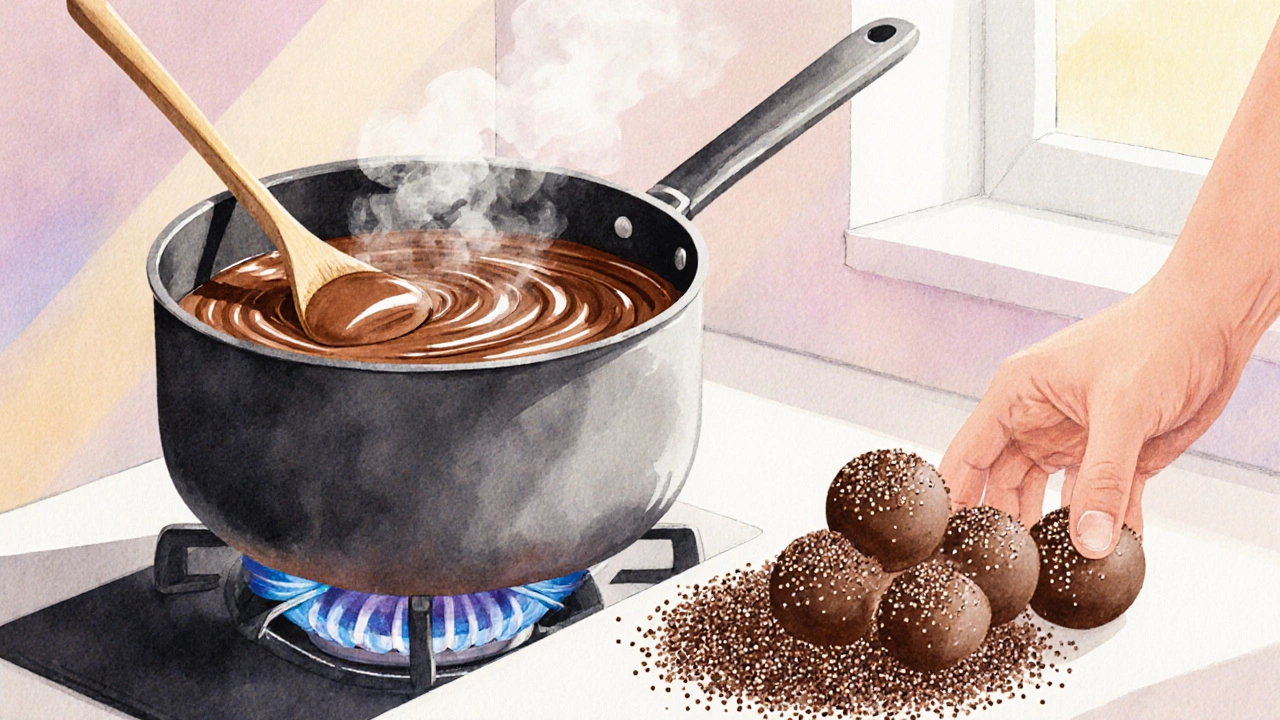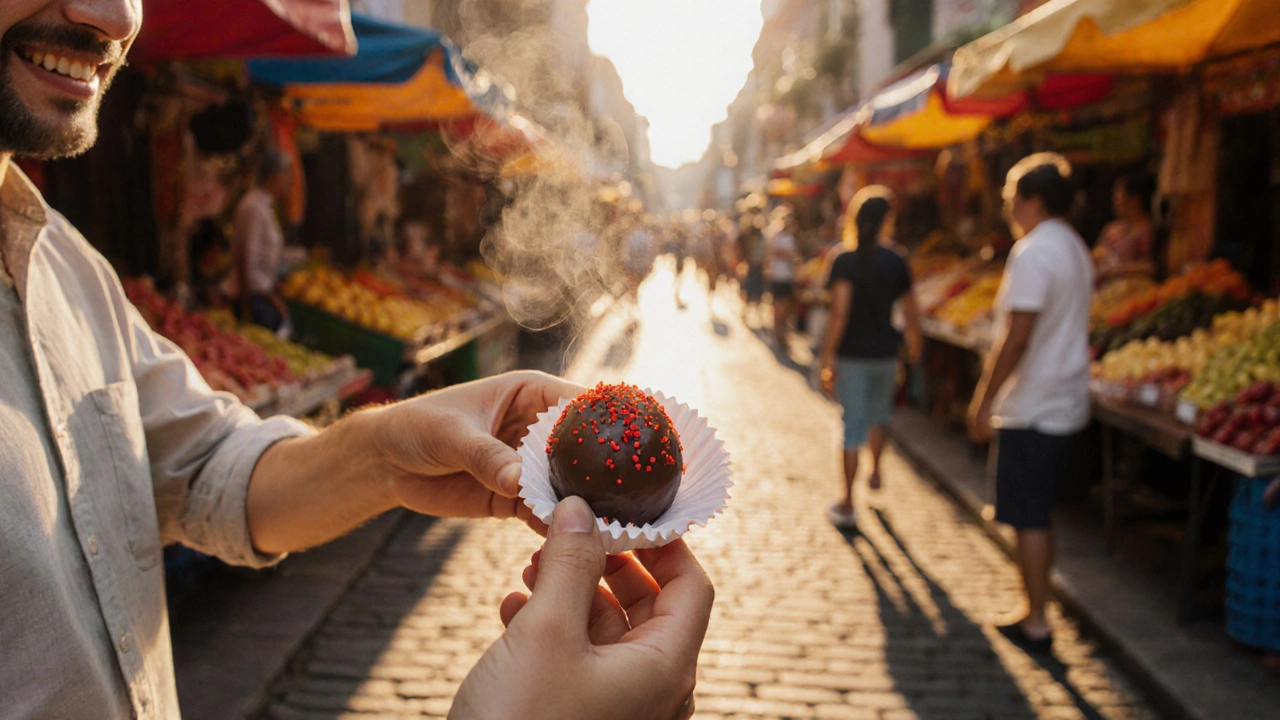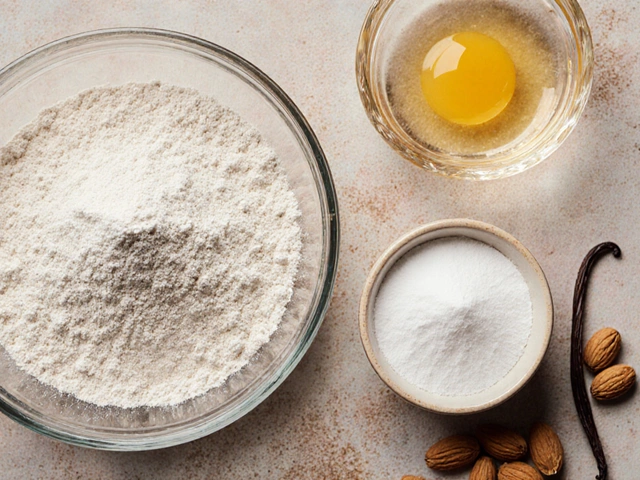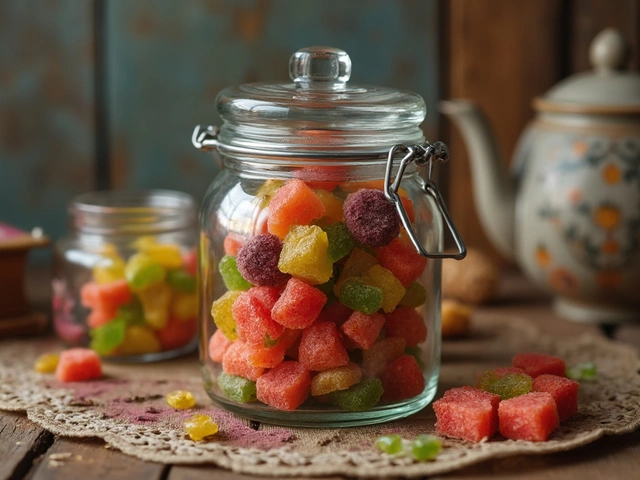Brigadeiro Popularity Quiz
How well do you know Brazil's most beloved dessert?
Answer the following questions to discover how much you know about brigadeiro compared to other Brazilian classics.
Answer all questions to see your results
Key Takeaways
- Brazil’s most iconic sweet is the Brigadeiro, a chocolate‑y truffle made from condensed milk, cocoa powder, butter and sprinkles.
- Its roots trace back to the 1940s, and it’s now a staple at birthdays, street fairs and coffee shops.
- Simple ingredients, a short cooking time, and endless flavor twists make it perfect for beginners.
- Compared with other Brazilian classics - beijinho, pudim, quindim - brigadeiro wins on popularity and ease of preparation.
- Common pitfalls: over‑cooking, low‑heat mixing, and using the wrong chocolate coating.
Imagine walking through a bustling Brazilian street market. The aroma of fresh coffee mingles with the sweet scent of chocolate melting in tiny pots. A vendor hands you a glossy, bite‑size ball dusted in chocolate sprinkles, and you instantly know you’ve found the country’s favorite treat.
When you think of Brazilian sweets, Brigadeiro is a chocolate‑flavored truffle made from sweetened condensed milk, cocoa powder, butter and chocolate sprinkles instantly comes to mind. This tiny confection has earned its place as the most famous dessert in Brazil, and it’s worth every bite.
Why Brigadeiro Became Brazil’s Sweet Symbol
Brigadeiro was born in the early 1940s, during a time when Brazil was looking for a new national identity. A chocolate company launched a campaign featuring the popular politician Brigadeiro Eduardo Gomes; the recipe was given away as a promotional giveaway. The name stuck, and the dessert quickly spread from the elite circles of Rio de Janeiro to the backyard parties of the north‑east.
Its rise was fueled by three key factors:
- Affordability: All ingredients are inexpensive and widely available.
- Ease of preparation: No fancy equipment, just a saucepan and a wooden spoon.
- Cultural fit: The sweet’s portable size makes it perfect for celebrations, from birthdays to soccer matches.
Today, you’ll find brigadeiros at every birthday cake, in school cafeterias, and even on the menus of high‑end restaurants that give a gourmet spin to the classic.
Core Ingredients - The Building Blocks
Condensed milk is a thick, sugary dairy product made by removing most of the water from cow’s milk and adding sugar. It provides the creamy base and the signature sweetness.
Cocoa powder gives the deep chocolate flavor and the rich brown color.
Butter adds a glossy texture and helps the mixture pull away from the pan.
Optional toppings include chocolate sprinkles (known locally as "granulado") for the classic look.

Step‑by‑Step: Classic Brigadeiro Recipe
- Gather 1can (395g) of sweetened condensed milk, 2tablespoons of cocoa powder, 2tablespoons of unsalted butter, and a pinch of salt.
- In a medium saucepan, combine the condensed milk, cocoa powder, butter and salt. Stir until the cocoa powder is fully dissolved.
- Place the pan over medium‑low heat. Cook, stirring constantly with a wooden spoon, for about 10‑12minutes. The mixture will thicken and you’ll see the bottom of the pan at a slower pace when you scrape it.
- When the mass pulls away from the sides and forms a glossy ball, remove it from the heat and let it cool to room temperature (about 20‑30minutes).
- Lightly butter your hands, scoop a small amount (about 1in≈2cm in diameter), roll it into a smooth sphere, and roll the ball in chocolate sprinkles.
- Place each finished brigadeiro in a paper candy cup. Serve at room temperature or slightly chilled.
Pro tip: If the mixture sticks to the spoon near the end, lower the heat a notch and keep stirring. This prevents scorching and yields a shiny finish.
Flavor Twists and Creative Variations
Once you master the classic version, the sky’s the limit. Here are five crowd‑pleasing twists:
- Beijinho: Swap cocoa powder for ½cup of grated coconut and roll the balls in toasted coconut flakes. Beijinho is a coconut‑flavored brigadeiro variant.
- Nutty Crunch: Add a tablespoon of finely chopped toasted peanuts to the base and coat the finished balls in crushed peanuts.
- Espresso Boost: Dissolve 1teaspoon of instant espresso in the condensed milk before adding cocoa for a coffee‑kicked treat.
- Fruit Infused: Mix in 2tablespoons of passion‑fruit puree after removing the pan from heat for a tangy surprise.
- Gourmet Dark: Use high‑quality 70% dark chocolate chips instead of cocoa powder, and finish with a dusting of cacao nibs.
How Brigadeiro Stacks Up Against Other Brazilian Classics
| Dessert | Main Ingredients | Typical Serving | First Recorded Year |
|---|---|---|---|
| Brigadeiro | Condensed milk, cocoa powder, butter, chocolate sprinkles | 1‑2in bite‑size balls | 1940 |
| Beijinho | Condensed milk, coconut, butter, toasted coconut | 1‑2in bite‑size balls | 1940s |
| Pudim de leite condensado | Condensed milk, whole milk, eggs, caramel sauce | Slice (≈8cm) | Early 20thcentury |
| Quindim | Coconut, sugar, egg yolks, butter | Small custard tart (≈3cm) | 1930s |
While each dessert has its devoted fans, brigadeiro leads in three measurable ways: the number of recipes published online, the frequency of appearance at public events, and the sheer volume of sales of ready‑made mixes. Its simplicity also makes it the go‑to dessert for improvising cooks.

When & Where to Serve Brigadeiro
Brigadeiro shines at any celebration that calls for a sweet bite. Common scenarios include:
- Birthdays: The classic “birthday brigadeiro” is a must‑have after the cake.
- Festivals & fairs: Street vendors sell them in paper cups for a quick snack.
- Coffee breaks: They pair perfectly with a strong Brazilian coffee (cafézinho).
- Corporate events: Bite‑size portions fit nicely on dessert platters.
If you’re traveling in Brazil, look for brigadeiros in:
- Bakery “padarias” - you’ll often find them displayed in glass cases.
- Supermarkets - pre‑packaged versions are sold alongside other sweets.
- Specialty chocolate shops - they might offer premium variations with exotic nuts or liquors.
Common Mistakes and How to Fix Them
- Over‑cooking: The mixture becomes grainy and loses its glossy sheen. Solution: watch the pan closely, stir constantly, and remove from heat as soon as it pulls away.
- Low‑heat neglect: Cooking on too high a flame scorches the bottom. Solution: keep the temperature medium‑low and use a heavy‑bottomed saucepan.
- Wrong chocolate coating: Sprinkles that melt too quickly make the brigadeiro sticky. Solution: use high‑quality, non‑melting granulado or roll in cocoa powder for a matte finish.
Quick Checklist Before You Start
- Gather all ingredients and measure them accurately.
- Use a heavy saucepan to avoid hot spots.
- Keep butter and sprinkles within reach for immediate coating.
- Have a bowl of cold water ready - if the mixture sticks, a quick dip helps it cool faster.
- Butter your hands lightly before shaping - this prevents sticking.
Frequently Asked Questions
What is a brigadeiro?
A brigadeiro is a small, chocolate‑flavored truffle made from sweetened condensed milk, cocoa powder, butter and chocolate sprinkles. It’s Brazil’s go‑to party sweet and is enjoyed all year round.
Can I make brigadeiros without cocoa powder?
Yes. The coconut‑based version is called Beijinho. Replace cocoa powder with grated coconut and finish the balls with toasted coconut flakes.
How long do brigadeiros keep?
Stored in an airtight container in the refrigerator, they stay fresh for up to 7days. Bring them to room temperature before serving for the best texture.
Can I freeze brigadeiros?
Yes. After they have cooled, place them in a freezer‑safe bag, separate each with parchment paper, and freeze for up to 3months. Thaw in the fridge for several hours before serving.
What are the healthiest alternatives?
Swap regular condensed milk for a low‑sugar or plant‑based version, use dark cocoa powder (70%+), and replace chocolate sprinkles with unsweetened cacao nibs. The flavor stays rich while cutting sugar.
Now that you know why brigadeiro rules the Brazilian dessert scene, how to craft the perfect batch, and how it compares to its tasty cousins, go ahead and make a batch for yourself. Whether you’re celebrating a birthday or just craving a sweet bite, the brigadeiro will never disappoint.





